One of the “must do” activities when visiting Guadalajara, whether it’s raining or not, is a side trip to the town of Tequila to get a glimpse at how Mexico’s national beverage is produced.
The town of Tequila is located about 37 miles west of Guadalajara. Many of the 30 or so tequila distilleries in and around Tequila offer factory tours, but the granddaddy of them all, and the one with the most tour options is the José Cuervo factory right in the center of town.
The José Cuervo distillery has created a tourist experience they call Mundo Cuervo (Cuervo World). You can access as much or as little of 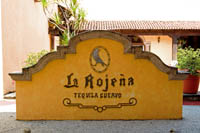 Mundo Cuervo as you have time for and fits into your budget. At the main distillery in Tequila, you can show up for a basic factory tour, which includes a tour of the distillery, La Rojeńa (named for the Cuervo son-in-law, Vincente Albino-Rojas, who acquired it as his wife’s dowry in 1812), access to the restaurant, gallery and gift shop and a margarita at the Margarita Bar. A Tasting Tour adds a sit-down tequila tasting in the Margarita Bar. A Reserva Cellar Tour adds a visit to the exclusive Reserva de la Familia (Family Reserve) aging cellar and a tasting of this premium tequila straight from the barrel under the supervision of the house tequillero. The VIP Tour is a private tour including all of the above. As of Nov 2005 prices range from 75 pesos ($7.50 US) for a basic factory tour to 250 pesos ($25 US) for a VIP Tour.
Mundo Cuervo as you have time for and fits into your budget. At the main distillery in Tequila, you can show up for a basic factory tour, which includes a tour of the distillery, La Rojeńa (named for the Cuervo son-in-law, Vincente Albino-Rojas, who acquired it as his wife’s dowry in 1812), access to the restaurant, gallery and gift shop and a margarita at the Margarita Bar. A Tasting Tour adds a sit-down tequila tasting in the Margarita Bar. A Reserva Cellar Tour adds a visit to the exclusive Reserva de la Familia (Family Reserve) aging cellar and a tasting of this premium tequila straight from the barrel under the supervision of the house tequillero. The VIP Tour is a private tour including all of the above. As of Nov 2005 prices range from 75 pesos ($7.50 US) for a basic factory tour to 250 pesos ($25 US) for a VIP Tour.
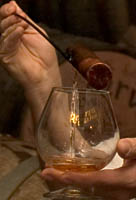 When the Spaniards colonized Mexico in the 1500s, they found the native people drinking a fermented beverage called pulque made from the heart of the maguey or agave plant. The Spaniards were running low on the spirits they had brought with them from Spain, so they distilled the pulque, creating the first mezcal wine. After a temporary ban on mezcal production in 1785, the King of Spain granted José Cuervo (Joe Crow) the first official license to produce mezcal wine in 1795. The Cuervo distillery was the first to give the name “tequila” to the type of mezcal wine produced exclusively from the heart of blue agave plants. With few exceptions, to have the designation of “tequila,” a mezcal must be produced from blue agave grown in the dry highlands of Jalisco and a few surrounding states and distilled in this same area.
When the Spaniards colonized Mexico in the 1500s, they found the native people drinking a fermented beverage called pulque made from the heart of the maguey or agave plant. The Spaniards were running low on the spirits they had brought with them from Spain, so they distilled the pulque, creating the first mezcal wine. After a temporary ban on mezcal production in 1785, the King of Spain granted José Cuervo (Joe Crow) the first official license to produce mezcal wine in 1795. The Cuervo distillery was the first to give the name “tequila” to the type of mezcal wine produced exclusively from the heart of blue agave plants. With few exceptions, to have the designation of “tequila,” a mezcal must be produced from blue agave grown in the dry highlands of Jalisco and a few surrounding states and distilled in this same area.
Mezcal (or mescal) is still the generic term for all spirits distilled from agave plants. Other mezcals are made from any of the other 136 varieties of agave, and they can be grown and distilled in other parts of Mexico. So even though tequila is a type of mezcal, all mezcals are not tequila.
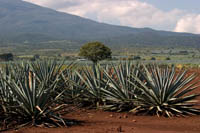 Coming from Guadalajara you drive through miles of the spiky blue-green agave, which, despite rumors to the contrary, is not a cactus. This succulent is part of the lily family which also includes its cousin, yucca. On an organized tour, your first stop is at one of these agave fields on the Cuervo plantation. If it’s wet, be sure to stick to the stone driveway or you’ll sink into the wet clay of the fields.
Coming from Guadalajara you drive through miles of the spiky blue-green agave, which, despite rumors to the contrary, is not a cactus. This succulent is part of the lily family which also includes its cousin, yucca. On an organized tour, your first stop is at one of these agave fields on the Cuervo plantation. If it’s wet, be sure to stick to the stone driveway or you’ll sink into the wet clay of the fields.
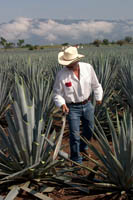 Here, we learn that an agave plant takes eight to twelve years to mature enough for harvesting and can grow to 12 or 14 feet in diameter. A jimador (agave harvester) demonstrates how the spikes are cut off the leaves of the agave with a machete to make them less sharp to work with; to force the nutrients to the heart of the agave, making it grow larger; and to prevent butterflies from nesting in the tips. The butterfly larvae or worms that are sometimes found in a bottle of mezcal, are never found in tequila. “If it is tequila” says Guillermo, our English-speaking guide, “there is no worm.” If left to grow wild, the agave would sprout a tall flower in the center, but these are also cut off to make the heart grow larger and sweeter.
Here, we learn that an agave plant takes eight to twelve years to mature enough for harvesting and can grow to 12 or 14 feet in diameter. A jimador (agave harvester) demonstrates how the spikes are cut off the leaves of the agave with a machete to make them less sharp to work with; to force the nutrients to the heart of the agave, making it grow larger; and to prevent butterflies from nesting in the tips. The butterfly larvae or worms that are sometimes found in a bottle of mezcal, are never found in tequila. “If it is tequila” says Guillermo, our English-speaking guide, “there is no worm.” If left to grow wild, the agave would sprout a tall flower in the center, but these are also cut off to make the heart grow larger and sweeter.
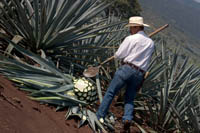 The jimador demonstrates on another plant how the agave is harvested, using a flat blade tool called a coa to cut off the leaves exposing the heart of the agave or pińa (called pineapple for its shape). The pińas usually weigh anywhere from 80 to 200 pounds. A good jimador can harvest over a ton of pińas in a day. The pińas are loaded onto trucks and taken into town to the distillery. Our jimador slices one in half and cuts off slivers for us to taste. It reminds me of jicama, a texture similar to a potato, but sweeter.
The jimador demonstrates on another plant how the agave is harvested, using a flat blade tool called a coa to cut off the leaves exposing the heart of the agave or pińa (called pineapple for its shape). The pińas usually weigh anywhere from 80 to 200 pounds. A good jimador can harvest over a ton of pińas in a day. The pińas are loaded onto trucks and taken into town to the distillery. Our jimador slices one in half and cuts off slivers for us to taste. It reminds me of jicama, a texture similar to a potato, but sweeter.
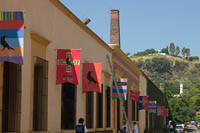 From the agave fields we continue into the town of Tequila, where the Cuervo factory, La Rojeńa, takes pride of place in the center of town, just off the plaza. The buildings of Mundo Cuervo actually fill two blocks on opposite sides of Calle José Cuervo. The Sauza Family Museum is on the other side of an adjoining wall and the National Tequila Museum is across Calle Ramon Corona. Street names change almost every block.
From the agave fields we continue into the town of Tequila, where the Cuervo factory, La Rojeńa, takes pride of place in the center of town, just off the plaza. The buildings of Mundo Cuervo actually fill two blocks on opposite sides of Calle José Cuervo. The Sauza Family Museum is on the other side of an adjoining wall and the National Tequila Museum is across Calle Ramon Corona. Street names change almost every block.
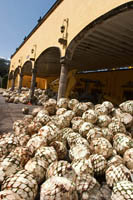 The main entrance to Mundo Cuervo is through an archway on the left side of Calle José Cuervo, across the street from Mundo Cuervo’s Cholula restaurant. The courtyard entrance to the factory is filled with a giant sculpture of a bird, representing the Cuervo crow, an oft repeated theme throughout Mundo Cuervo. Its live counterpart has pride of place in a cage in an inner courtyard. The Cuervo tour is an indoor-outdoor experience, but if it’s raining, they have enough umbrellas for everyone.
The main entrance to Mundo Cuervo is through an archway on the left side of Calle José Cuervo, across the street from Mundo Cuervo’s Cholula restaurant. The courtyard entrance to the factory is filled with a giant sculpture of a bird, representing the Cuervo crow, an oft repeated theme throughout Mundo Cuervo. Its live counterpart has pride of place in a cage in an inner courtyard. The Cuervo tour is an indoor-outdoor experience, but if it’s raining, they have enough umbrellas for everyone.
Tours begin with an orientation video in Spanish with English subtitles that introduces you to the history of Casa José Cuervo and the process of growing blue agave and turning it into fine tequilas. Then we follow our guide into the factory area where pińas are piled high waiting to be split and shoveled into room-sized steam ovens.
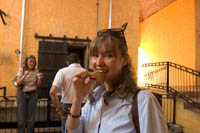 The pińas cook in the steam ovens for 36 hours to convert the starches to sugar. We get to taste a slice of the cooked agave. Although the sign says it tastes like yam, I find it much sweeter, almost like raw sugar cane, but with a tequila aftertaste.
The pińas cook in the steam ovens for 36 hours to convert the starches to sugar. We get to taste a slice of the cooked agave. Although the sign says it tastes like yam, I find it much sweeter, almost like raw sugar cane, but with a tequila aftertaste.
After cooking, the clumps of agave are allowed to cool for eight hours before being hand loaded onto conveyor belts that take them into the mill. Four mills tear up the pińas, grind them and press out the liquid. The liquid from the milled agave, called mosto or “must” is gathered in stainless steel vats where yeast is added and it ferments for about 18 hours, transforming the sugars into alcohol.
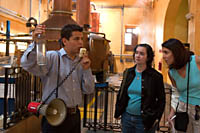 The brown fermented liquid is then distilled twice in copper stills resulting in a clear tequila that is about 55% alcohol. Since 40% is the maximum allowed, it has to be diluted with de-mineralized water to reduce the alcohol content. This fresh tequila,Tequila Blanco – also called plata or silver – is stored in stainless steel vats and bottled within 15 days.
The brown fermented liquid is then distilled twice in copper stills resulting in a clear tequila that is about 55% alcohol. Since 40% is the maximum allowed, it has to be diluted with de-mineralized water to reduce the alcohol content. This fresh tequila,Tequila Blanco – also called plata or silver – is stored in stainless steel vats and bottled within 15 days.
To mellow out the sharp taste, some of the tequila is aged in American or 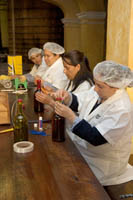 French oak barrels. Tequila aged from two months to a year is considered Tequila Reposado or rested. Aging in wood adds color as well as flavor to the tequila. Tequila aged a year or more is Tequila Ańejo. These are grades of tequila, not brands. The tour guide explains the differences between Cuervo’s various tequila brands.
French oak barrels. Tequila aged from two months to a year is considered Tequila Reposado or rested. Aging in wood adds color as well as flavor to the tequila. Tequila aged a year or more is Tequila Ańejo. These are grades of tequila, not brands. The tour guide explains the differences between Cuervo’s various tequila brands.
In the Reserva Museum, we watch a quintet of workers hand-bottling, labeling and packaging the most precious of Cuervo’s brands, Reserva de la Familia – in slow motion for our benefit. As the tour group passes, production speeds up considerably. Tourists who chose the basic or tasting tours receive a thimble full of Reserva to taste before moving on to the Margarita Bar. Those of us on the Reserva Cellar Tour continue down to the Cava or cellar, the warehouse of the original factory which is now used exclusively for aging the Ańejos three years or older used to blend each year’s Family Reserve.
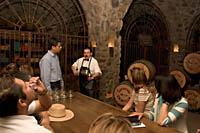 A tequillero extracts a measure of amber tequila directly from the barrel and pours it into a brandy snifter for each guest. Just like a wine tasting, we are instructed how to test the bouquet, the color and the body of the tequila before tasting it. This is definitely a sipping tequila, having many of the same properties as a good cognac or brandy.
A tequillero extracts a measure of amber tequila directly from the barrel and pours it into a brandy snifter for each guest. Just like a wine tasting, we are instructed how to test the bouquet, the color and the body of the tequila before tasting it. This is definitely a sipping tequila, having many of the same properties as a good cognac or brandy.
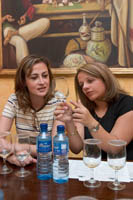 The problem with having the regular tequila testing after our visit to the Cellar is that nothing can compare with the Reserva we have just tasted. However, our palates are cleared a bit with the frozen margaritas that greet us in the courtyard of the Margarita Bar. Inside, the table is pre-set with three capped glasses of tequila at each place and a bilingual cheat sheet reviewing what to look for in a tasting. Interestingly, the three tequilas presented in the tasting are not even José Cuervo labels, they are a Blanco, a Reposado and an Ańejo that Cuervo produces under its Gran Centenario label.
The problem with having the regular tequila testing after our visit to the Cellar is that nothing can compare with the Reserva we have just tasted. However, our palates are cleared a bit with the frozen margaritas that greet us in the courtyard of the Margarita Bar. Inside, the table is pre-set with three capped glasses of tequila at each place and a bilingual cheat sheet reviewing what to look for in a tasting. Interestingly, the three tequilas presented in the tasting are not even José Cuervo labels, they are a Blanco, a Reposado and an Ańejo that Cuervo produces under its Gran Centenario label.
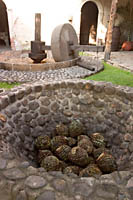 Off of the courtyard by the Margarita Bar is a gallery that wraps around to a gift shop selling fine art and hand crafts. Across the street, in an open courtyard, you can see part of the original distillery where the agave were roasted in underground pits and then milled with a grinding stone pulled by a mule. Another gift shop, where you can buy tequila and related products is in this courtyard.
Off of the courtyard by the Margarita Bar is a gallery that wraps around to a gift shop selling fine art and hand crafts. Across the street, in an open courtyard, you can see part of the original distillery where the agave were roasted in underground pits and then milled with a grinding stone pulled by a mule. Another gift shop, where you can buy tequila and related products is in this courtyard.
A little further down the street the Mundo Cuervo Museum houses exhibits of Mexican folk culture in the original hacienda. The Museum is sometimes closed for private meetings, conferences and events, so it is not always included in the tour. Public events are also held here. Mundo Cuervo has local Ballet Folklorico and pre-Hispanic dance groups and two Mariachi bands on staff. They are sometimes sent touring around the world to promote José Cuervo, but also participate in private functions at Mundo Cuervo and at local community events.
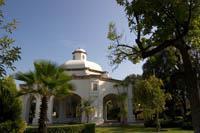 The gardens of the hacienda include a large gazebo often used for weddings and dances and a rodeo ring for charreria demonstrations. Through a fence, you can see the homestead where the family still stays when they are in town.
The gardens of the hacienda include a large gazebo often used for weddings and dances and a rodeo ring for charreria demonstrations. Through a fence, you can see the homestead where the family still stays when they are in town.
Mundo Cuervo has just added more conference and exhibition facilities on the other side of the street behind the factory. They are planning to use the stage area as a movie house for the local community when other activities are not scheduled.
Mundo Cuervo Tours are held on the hour Monday through Saturday 10 a.m. to 4 p.m., Sunday 11 a.m. to 1 p.m. I recommend calling ahead to arrange VIP tours and to make sure an English-speaking guide is available (not usually an issue, but it doesn’t hurt to make sure). Visit the web site www.mundocuervo.com or for information in Guadalajara, call (33) 3134-3368, or email: cuervo-tours@cuervo.com.mx . For information in Tequila, call (374) 742-2170 / 1168 or email:tours@cuervo.com.mx
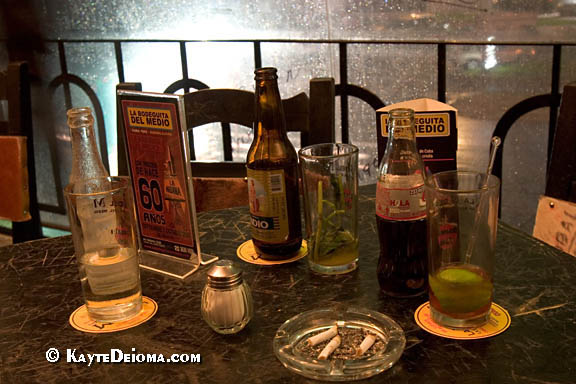
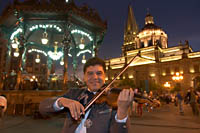 Guadalajara, Jalisco is known as the most Mexican of Mexican cities. It is the birthplace of such Mexican icons as Mariachi, Tequila and the Charro or Mexican cowboy. Many of the traditional folk arts we recognize as Mexican are also created here. It is Mexico’s second largest city with a population of 1.6 million in the City proper and over four million in the metropolitan area. Greater Guadalajara includes the municipalities of Tlaqupaque, Zapopan and Tonolá as well as the city of Guadalajara. Each has its own distinct historical center, but their modern suburbs have become intertwined.
Guadalajara, Jalisco is known as the most Mexican of Mexican cities. It is the birthplace of such Mexican icons as Mariachi, Tequila and the Charro or Mexican cowboy. Many of the traditional folk arts we recognize as Mexican are also created here. It is Mexico’s second largest city with a population of 1.6 million in the City proper and over four million in the metropolitan area. Greater Guadalajara includes the municipalities of Tlaqupaque, Zapopan and Tonolá as well as the city of Guadalajara. Each has its own distinct historical center, but their modern suburbs have become intertwined.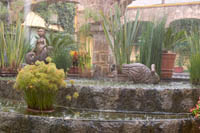 The “pearl of Jalisco,” as the city is known, has a wonderful climate for year-round outdoor activities with average high temperatures in the 70s and 80s all year long. June through September is the rainy season, with July averaging 20 days of rain. El Nińo conditions extended the rain through October this year. That doesn’t mean that it will rain all day long for days at a time, but you should always be prepared for a cloudburst.
The “pearl of Jalisco,” as the city is known, has a wonderful climate for year-round outdoor activities with average high temperatures in the 70s and 80s all year long. June through September is the rainy season, with July averaging 20 days of rain. El Nińo conditions extended the rain through October this year. That doesn’t mean that it will rain all day long for days at a time, but you should always be prepared for a cloudburst.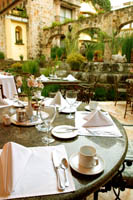 patio restaurant for the duration of the downpour. I could have ensconced myself with a good guide book in my golden suite to wait out the rain at this all-suite boutique hotel with a colonial flavor. I could have taken up residence in the bar for a signature Mariana (a kiwi strawberry margarita with salt and chili powder on the rim of the glass), or lingered in the restaurant to enjoy any of Chef Gabriel Duram’s scrumptious meals accompanied by a variety of musicians who play for breakfast, lunch and dinner. I could have explored the collection of one-of-a-kind historical Spanish and Mexican artwork displayed throughout the hotel’s public areas, or spent some time catching up on email in the business center. And to tell the truth, I did all of those things, but still found some rainy and not-so rainy moments to explore other rainy day possibilities in this beautiful city.
patio restaurant for the duration of the downpour. I could have ensconced myself with a good guide book in my golden suite to wait out the rain at this all-suite boutique hotel with a colonial flavor. I could have taken up residence in the bar for a signature Mariana (a kiwi strawberry margarita with salt and chili powder on the rim of the glass), or lingered in the restaurant to enjoy any of Chef Gabriel Duram’s scrumptious meals accompanied by a variety of musicians who play for breakfast, lunch and dinner. I could have explored the collection of one-of-a-kind historical Spanish and Mexican artwork displayed throughout the hotel’s public areas, or spent some time catching up on email in the business center. And to tell the truth, I did all of those things, but still found some rainy and not-so rainy moments to explore other rainy day possibilities in this beautiful city.
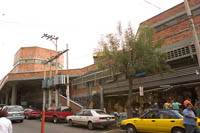 names. The official name is Mercado Libertad or Liberty Market. Most locals refer to it as Mercado San Juan de Dios ( St. John of God Market) after the nearby church and neighborhood of the same name. Still others call it Mercado “Taiwan de Dios” for the piles of imported electronics sold there. By any name, Latin America’s largest indoor market can keep you occupied and out of the rain for a good long while, even if you’re not a shopper. If you are a shopper, feel free to haggle, but keep in mind that wages in Mexico are really low, so don’t try to drive too hard a bargain.
names. The official name is Mercado Libertad or Liberty Market. Most locals refer to it as Mercado San Juan de Dios ( St. John of God Market) after the nearby church and neighborhood of the same name. Still others call it Mercado “Taiwan de Dios” for the piles of imported electronics sold there. By any name, Latin America’s largest indoor market can keep you occupied and out of the rain for a good long while, even if you’re not a shopper. If you are a shopper, feel free to haggle, but keep in mind that wages in Mexico are really low, so don’t try to drive too hard a bargain.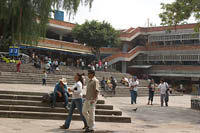 With over 1000 vendors, there’s not much for sale that can’t be found at the Mercado. The problem is that the market is so vast and the aisles are so narrow, that many people wander around for an hour and think they’ve seen it all, when they’ve barely scratched the surface. I can’t claim to be an expert. I spent about three hours and still only saw a fraction of what there was to see.
With over 1000 vendors, there’s not much for sale that can’t be found at the Mercado. The problem is that the market is so vast and the aisles are so narrow, that many people wander around for an hour and think they’ve seen it all, when they’ve barely scratched the surface. I can’t claim to be an expert. I spent about three hours and still only saw a fraction of what there was to see.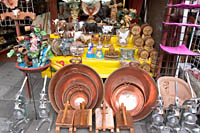 the plazas downtown, you’ll most likely be approaching from the north or west. From the north, you’ll probably want to skip most of the housewares in the outer booths along the long north side. If you don’t have a lot of time, walk along the outside of the market to where you see the more traditional copper vats and clay cooking pots.
the plazas downtown, you’ll most likely be approaching from the north or west. From the north, you’ll probably want to skip most of the housewares in the outer booths along the long north side. If you don’t have a lot of time, walk along the outside of the market to where you see the more traditional copper vats and clay cooking pots.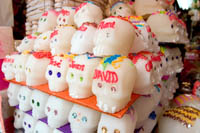 Keep an eye out on your way for some of the traditional Mexican sweets, like the sugar skulls for Day of the Dead. Then look for the basket vendor at the corner of an aisle that looks through to daylight on the other side. That should take you past hand made wooden toys, maracas and other arts and craft vendors on the way in to the patio.
Keep an eye out on your way for some of the traditional Mexican sweets, like the sugar skulls for Day of the Dead. Then look for the basket vendor at the corner of an aisle that looks through to daylight on the other side. That should take you past hand made wooden toys, maracas and other arts and craft vendors on the way in to the patio.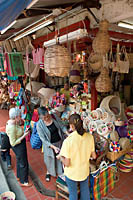 On the closest (north) side of the patio, you’ll find hand-woven baskets and bags, papier-mâché masks and dolls, clay and pottery miniatures and a wide variety of folk arts from the Guadalajara Metro area, the most important producer of hand crafts in the country.
On the closest (north) side of the patio, you’ll find hand-woven baskets and bags, papier-mâché masks and dolls, clay and pottery miniatures and a wide variety of folk arts from the Guadalajara Metro area, the most important producer of hand crafts in the country.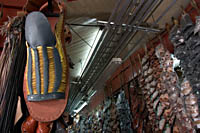 But if you’re looking for Mexican-made leather boots and sandals, you might want to start at the northern entrance that leads straight up the stairs to a row of cobblers and shoe vendors. You may spot one of Maximo Pelayo’s giant huarache sandals hanging at the top of the stairway above the rows of footwear made for normal-sized folks. His giant huaraches have found their way into Mexican restaurants and other establishments on both sides of the border. He makes them right there on the spot.
But if you’re looking for Mexican-made leather boots and sandals, you might want to start at the northern entrance that leads straight up the stairs to a row of cobblers and shoe vendors. You may spot one of Maximo Pelayo’s giant huarache sandals hanging at the top of the stairway above the rows of footwear made for normal-sized folks. His giant huaraches have found their way into Mexican restaurants and other establishments on both sides of the border. He makes them right there on the spot.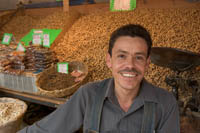 Vendors tend to be grouped together by product categories, so if you’re looking for something in particular, it’s best to ask directions to that part of the market, although within this order there is also a random mix of vendors outside of their product zone. Most vendors know numbers and prices in English. Some also know enough to point you in the right direction to find what you’re looking for. Toiletries, perfumes, watches, office supplies, groceries
everything but packaged liquor and pharmaceuticals can be bought at the market.
Vendors tend to be grouped together by product categories, so if you’re looking for something in particular, it’s best to ask directions to that part of the market, although within this order there is also a random mix of vendors outside of their product zone. Most vendors know numbers and prices in English. Some also know enough to point you in the right direction to find what you’re looking for. Toiletries, perfumes, watches, office supplies, groceries
everything but packaged liquor and pharmaceuticals can be bought at the market.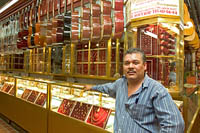 There’s a section for handmade leather goods, from belts to jackets to boots to hats. There are long counters of silver and gold jewelry with guitars hanging overhead, an odd, but common combination in this market. Guitars seem to go with anything.
There’s a section for handmade leather goods, from belts to jackets to boots to hats. There are long counters of silver and gold jewelry with guitars hanging overhead, an odd, but common combination in this market. Guitars seem to go with anything.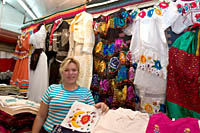 On the north side of level 2, along with cobblers and other shoe vendors, hardware (hammers, saws, etc.) can be found next to music CDs and electronics. Contemporary clothes and lots more shoes are on level three. If you’re looking for Mexican blankets, traditional clothes, sombreros or T-shirts, the first aisle along the east end closest to the parking structure has a good selection.
On the north side of level 2, along with cobblers and other shoe vendors, hardware (hammers, saws, etc.) can be found next to music CDs and electronics. Contemporary clothes and lots more shoes are on level three. If you’re looking for Mexican blankets, traditional clothes, sombreros or T-shirts, the first aisle along the east end closest to the parking structure has a good selection.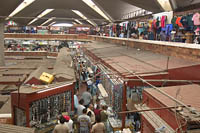 Levels two and three are open in the middle like a shopping mall, but rather than a fountain in the middle, you look down on the roofs of the first floor stalls. I could look across from the east side of level two and see all the food vendors on the west side, but I never made it over there in my three hours of exploring. I did come across another area of sandwich booths on the south side selling a variety of tortas (sandwiches on large rolls) between the butchers and the spice vendors.
Levels two and three are open in the middle like a shopping mall, but rather than a fountain in the middle, you look down on the roofs of the first floor stalls. I could look across from the east side of level two and see all the food vendors on the west side, but I never made it over there in my three hours of exploring. I did come across another area of sandwich booths on the south side selling a variety of tortas (sandwiches on large rolls) between the butchers and the spice vendors.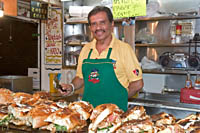 For American sensibilities, the butcher aisle is a bit of a culture shock. Every part of the animal is hanging in front of you, exposed to the air and available for purchase. Seeing all the hanging heads, feet and intestines didn’t really give me much of an appetite, but I found it fascinating.
For American sensibilities, the butcher aisle is a bit of a culture shock. Every part of the animal is hanging in front of you, exposed to the air and available for purchase. Seeing all the hanging heads, feet and intestines didn’t really give me much of an appetite, but I found it fascinating. Mundo Cuervo as you have time for and fits into your budget. At the main distillery in Tequila, you can show up for a basic factory tour, which includes a tour of the distillery, La Rojeńa (named for the Cuervo son-in-law, Vincente Albino-Rojas, who acquired it as his wife’s dowry in 1812), access to the restaurant, gallery and gift shop and a margarita at the Margarita Bar. A Tasting Tour adds a sit-down tequila tasting in the Margarita Bar. A Reserva Cellar Tour adds a visit to the exclusive Reserva de la Familia (Family Reserve) aging cellar and a tasting of this premium tequila straight from the barrel under the supervision of the house tequillero. The VIP Tour is a private tour including all of the above. As of Nov 2005 prices range from 75 pesos ($7.50 US) for a basic factory tour to 250 pesos ($25 US) for a VIP Tour.
Mundo Cuervo as you have time for and fits into your budget. At the main distillery in Tequila, you can show up for a basic factory tour, which includes a tour of the distillery, La Rojeńa (named for the Cuervo son-in-law, Vincente Albino-Rojas, who acquired it as his wife’s dowry in 1812), access to the restaurant, gallery and gift shop and a margarita at the Margarita Bar. A Tasting Tour adds a sit-down tequila tasting in the Margarita Bar. A Reserva Cellar Tour adds a visit to the exclusive Reserva de la Familia (Family Reserve) aging cellar and a tasting of this premium tequila straight from the barrel under the supervision of the house tequillero. The VIP Tour is a private tour including all of the above. As of Nov 2005 prices range from 75 pesos ($7.50 US) for a basic factory tour to 250 pesos ($25 US) for a VIP Tour. When the Spaniards colonized Mexico in the 1500s, they found the native people drinking a fermented beverage called pulque made from the heart of the maguey or agave plant. The Spaniards were running low on the spirits they had brought with them from Spain, so they distilled the pulque, creating the first mezcal wine. After a temporary ban on mezcal production in 1785, the King of Spain granted José Cuervo (Joe Crow) the first official license to produce mezcal wine in 1795. The Cuervo distillery was the first to give the name “tequila” to the type of mezcal wine produced exclusively from the heart of blue agave plants. With few exceptions, to have the designation of “tequila,” a mezcal must be produced from blue agave grown in the dry highlands of Jalisco and a few surrounding states and distilled in this same area.
When the Spaniards colonized Mexico in the 1500s, they found the native people drinking a fermented beverage called pulque made from the heart of the maguey or agave plant. The Spaniards were running low on the spirits they had brought with them from Spain, so they distilled the pulque, creating the first mezcal wine. After a temporary ban on mezcal production in 1785, the King of Spain granted José Cuervo (Joe Crow) the first official license to produce mezcal wine in 1795. The Cuervo distillery was the first to give the name “tequila” to the type of mezcal wine produced exclusively from the heart of blue agave plants. With few exceptions, to have the designation of “tequila,” a mezcal must be produced from blue agave grown in the dry highlands of Jalisco and a few surrounding states and distilled in this same area. Coming from Guadalajara you drive through miles of the spiky blue-green agave, which, despite rumors to the contrary, is not a cactus. This succulent is part of the lily family which also includes its cousin, yucca. On an organized tour, your first stop is at one of these agave fields on the Cuervo plantation. If it’s wet, be sure to stick to the stone driveway or you’ll sink into the wet clay of the fields.
Coming from Guadalajara you drive through miles of the spiky blue-green agave, which, despite rumors to the contrary, is not a cactus. This succulent is part of the lily family which also includes its cousin, yucca. On an organized tour, your first stop is at one of these agave fields on the Cuervo plantation. If it’s wet, be sure to stick to the stone driveway or you’ll sink into the wet clay of the fields. Here, we learn that an agave plant takes eight to twelve years to mature enough for harvesting and can grow to 12 or 14 feet in diameter. A jimador (agave harvester) demonstrates how the spikes are cut off the leaves of the agave with a machete to make them less sharp to work with; to force the nutrients to the heart of the agave, making it grow larger; and to prevent butterflies from nesting in the tips. The butterfly larvae or worms that are sometimes found in a bottle of mezcal, are never found in tequila. “If it is tequila” says Guillermo, our English-speaking guide, “there is no worm.” If left to grow wild, the agave would sprout a tall flower in the center, but these are also cut off to make the heart grow larger and sweeter.
Here, we learn that an agave plant takes eight to twelve years to mature enough for harvesting and can grow to 12 or 14 feet in diameter. A jimador (agave harvester) demonstrates how the spikes are cut off the leaves of the agave with a machete to make them less sharp to work with; to force the nutrients to the heart of the agave, making it grow larger; and to prevent butterflies from nesting in the tips. The butterfly larvae or worms that are sometimes found in a bottle of mezcal, are never found in tequila. “If it is tequila” says Guillermo, our English-speaking guide, “there is no worm.” If left to grow wild, the agave would sprout a tall flower in the center, but these are also cut off to make the heart grow larger and sweeter. The jimador demonstrates on another plant how the agave is harvested, using a flat blade tool called a coa to cut off the leaves exposing the heart of the agave or pińa (called pineapple for its shape). The pińas usually weigh anywhere from 80 to 200 pounds. A good jimador can harvest over a ton of pińas in a day. The pińas are loaded onto trucks and taken into town to the distillery. Our jimador slices one in half and cuts off slivers for us to taste. It reminds me of jicama, a texture similar to a potato, but sweeter.
The jimador demonstrates on another plant how the agave is harvested, using a flat blade tool called a coa to cut off the leaves exposing the heart of the agave or pińa (called pineapple for its shape). The pińas usually weigh anywhere from 80 to 200 pounds. A good jimador can harvest over a ton of pińas in a day. The pińas are loaded onto trucks and taken into town to the distillery. Our jimador slices one in half and cuts off slivers for us to taste. It reminds me of jicama, a texture similar to a potato, but sweeter. From the agave fields we continue into the town of Tequila, where the Cuervo factory, La Rojeńa, takes pride of place in the center of town, just off the plaza. The buildings of Mundo Cuervo actually fill two blocks on opposite sides of Calle José Cuervo. The Sauza Family Museum is on the other side of an adjoining wall and the National Tequila Museum is across Calle Ramon Corona. Street names change almost every block.
From the agave fields we continue into the town of Tequila, where the Cuervo factory, La Rojeńa, takes pride of place in the center of town, just off the plaza. The buildings of Mundo Cuervo actually fill two blocks on opposite sides of Calle José Cuervo. The Sauza Family Museum is on the other side of an adjoining wall and the National Tequila Museum is across Calle Ramon Corona. Street names change almost every block. The main entrance to Mundo Cuervo is through an archway on the left side of Calle José Cuervo, across the street from Mundo Cuervo’s Cholula restaurant. The courtyard entrance to the factory is filled with a giant sculpture of a bird, representing the Cuervo crow, an oft repeated theme throughout Mundo Cuervo. Its live counterpart has pride of place in a cage in an inner courtyard. The Cuervo tour is an indoor-outdoor experience, but if it’s raining, they have enough umbrellas for everyone.
The main entrance to Mundo Cuervo is through an archway on the left side of Calle José Cuervo, across the street from Mundo Cuervo’s Cholula restaurant. The courtyard entrance to the factory is filled with a giant sculpture of a bird, representing the Cuervo crow, an oft repeated theme throughout Mundo Cuervo. Its live counterpart has pride of place in a cage in an inner courtyard. The Cuervo tour is an indoor-outdoor experience, but if it’s raining, they have enough umbrellas for everyone. The pińas cook in the steam ovens for 36 hours to convert the starches to sugar. We get to taste a slice of the cooked agave. Although the sign says it tastes like yam, I find it much sweeter, almost like raw sugar cane, but with a tequila aftertaste.
The pińas cook in the steam ovens for 36 hours to convert the starches to sugar. We get to taste a slice of the cooked agave. Although the sign says it tastes like yam, I find it much sweeter, almost like raw sugar cane, but with a tequila aftertaste. The brown fermented liquid is then distilled twice in copper stills resulting in a clear tequila that is about 55% alcohol. Since 40% is the maximum allowed, it has to be diluted with de-mineralized water to reduce the alcohol content. This fresh tequila,Tequila Blanco – also called plata or silver – is stored in stainless steel vats and bottled within 15 days.
The brown fermented liquid is then distilled twice in copper stills resulting in a clear tequila that is about 55% alcohol. Since 40% is the maximum allowed, it has to be diluted with de-mineralized water to reduce the alcohol content. This fresh tequila,Tequila Blanco – also called plata or silver – is stored in stainless steel vats and bottled within 15 days. French oak barrels. Tequila aged from two months to a year is considered Tequila Reposado or rested. Aging in wood adds color as well as flavor to the tequila. Tequila aged a year or more is Tequila Ańejo. These are grades of tequila, not brands. The tour guide explains the differences between Cuervo’s various tequila brands.
French oak barrels. Tequila aged from two months to a year is considered Tequila Reposado or rested. Aging in wood adds color as well as flavor to the tequila. Tequila aged a year or more is Tequila Ańejo. These are grades of tequila, not brands. The tour guide explains the differences between Cuervo’s various tequila brands. A tequillero extracts a measure of amber tequila directly from the barrel and pours it into a brandy snifter for each guest. Just like a wine tasting, we are instructed how to test the bouquet, the color and the body of the tequila before tasting it. This is definitely a sipping tequila, having many of the same properties as a good cognac or brandy.
A tequillero extracts a measure of amber tequila directly from the barrel and pours it into a brandy snifter for each guest. Just like a wine tasting, we are instructed how to test the bouquet, the color and the body of the tequila before tasting it. This is definitely a sipping tequila, having many of the same properties as a good cognac or brandy. The problem with having the regular tequila testing after our visit to the Cellar is that nothing can compare with the Reserva we have just tasted. However, our palates are cleared a bit with the frozen margaritas that greet us in the courtyard of the Margarita Bar. Inside, the table is pre-set with three capped glasses of tequila at each place and a bilingual cheat sheet reviewing what to look for in a tasting. Interestingly, the three tequilas presented in the tasting are not even José Cuervo labels, they are a Blanco, a Reposado and an Ańejo that Cuervo produces under its Gran Centenario label.
The problem with having the regular tequila testing after our visit to the Cellar is that nothing can compare with the Reserva we have just tasted. However, our palates are cleared a bit with the frozen margaritas that greet us in the courtyard of the Margarita Bar. Inside, the table is pre-set with three capped glasses of tequila at each place and a bilingual cheat sheet reviewing what to look for in a tasting. Interestingly, the three tequilas presented in the tasting are not even José Cuervo labels, they are a Blanco, a Reposado and an Ańejo that Cuervo produces under its Gran Centenario label. Off of the courtyard by the Margarita Bar is a gallery that wraps around to a gift shop selling fine art and hand crafts. Across the street, in an open courtyard, you can see part of the original distillery where the agave were roasted in underground pits and then milled with a grinding stone pulled by a mule. Another gift shop, where you can buy tequila and related products is in this courtyard.
Off of the courtyard by the Margarita Bar is a gallery that wraps around to a gift shop selling fine art and hand crafts. Across the street, in an open courtyard, you can see part of the original distillery where the agave were roasted in underground pits and then milled with a grinding stone pulled by a mule. Another gift shop, where you can buy tequila and related products is in this courtyard. The gardens of the hacienda include a large gazebo often used for weddings and dances and a rodeo ring for charreria demonstrations. Through a fence, you can see the homestead where the family still stays when they are in town.
The gardens of the hacienda include a large gazebo often used for weddings and dances and a rodeo ring for charreria demonstrations. Through a fence, you can see the homestead where the family still stays when they are in town.